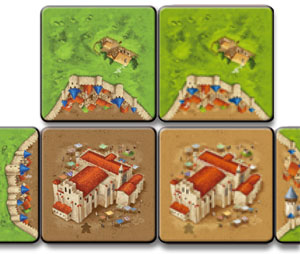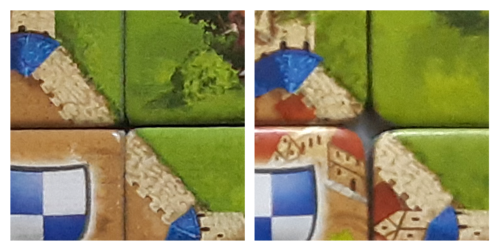Difference between revisions of "Visual Changes in the 2nd Edition/de"
(Updating to match new version of source page) |
(Updating to match new version of source page) |
||
| Line 1: | Line 1: | ||
<languages /> | <languages /> | ||
The Second | {{DISPLAYTITLE:Editing Visual Changes in the 2nd & 3rd Edition|noreplace}} | ||
The Second and Third Editions of Carcassonne share a similar visual style. These editions represent different milestones since the visual restyling of the game 14 years after its release. This new graphic style has also varied through the years, as you can see below. | |||
=== Die Städte der zweite Ausgabe hat anfangs dunklere Städte === | === Die Städte der zweite Ausgabe hat anfangs dunklere Städte === | ||
The Second Edition of Carcassonne (or C2 for short) has undergone a few changes in style since its release in {{Year|2014}}. These minor graphic changes do not affect the playability of the game but the visual appearance of the board when combining tiles from different editions or styles. | |||
[[File:Dark_Light_city.jpg|right]] | [[File:Dark_Light_city.jpg|right]] | ||
| Line 12: | Line 16: | ||
Im Beispiel rechts sind die beiden unterschiedlichen Drucke für eine der Kathedralen-Karten und einige benachbarte Karten dargestellt. (Bild kombiniert aus verschiedenen Versionen von PDF der Regeln für '''Wirtshäuser und Kathedralen''') | Im Beispiel rechts sind die beiden unterschiedlichen Drucke für eine der Kathedralen-Karten und einige benachbarte Karten dargestellt. (Bild kombiniert aus verschiedenen Versionen von PDF der Regeln für '''Wirtshäuser und Kathedralen''') | ||
<div class="mw-translate-fuzzy"> | |||
Innerhalb der Fangemeinde wird die dunklere Stadtversion als Carc 2.0, die hellere Stadtversion als Carc 2.1 bezeichnet. | Innerhalb der Fangemeinde wird die dunklere Stadtversion als Carc 2.0, die hellere Stadtversion als Carc 2.1 bezeichnet. | ||
</div> | |||
Während der gesamten Produktionsgeschichte gab es einige Probleme mit der Farbkonsistenz zwischen den verschiedenen Erweiterungen, und damit müssen wir als Spieler versuchen zu leben. Einige wenige mögen ästhetische Probleme mit der Kombination von Erweiterungen aus den beiden verschiedenen Drucken haben, aber die Karten sind topologisch identisch. | Während der gesamten Produktionsgeschichte gab es einige Probleme mit der Farbkonsistenz zwischen den verschiedenen Erweiterungen, und damit müssen wir als Spieler versuchen zu leben. Einige wenige mögen ästhetische Probleme mit der Kombination von Erweiterungen aus den beiden verschiedenen Drucken haben, aber die Karten sind topologisch identisch. | ||
| Line 32: | Line 38: | ||
]] | ]] | ||
Since {{Year|2020}}, the new releases | Since {{Year|2020}}, the new releases kicked-off the Third Edition of Carcassonne (or C3 for short) with a few exceptions. This new edition changed their tile shape and graphic style, the latter affecting cities most noticeably: | ||
* Tiles feature rounder corners than previous sets and expansions. | * Tiles feature rounder corners than previous sets and expansions. | ||
* The artwork style tends to show more detailed graphics and textured buildings. | * The artwork style tends to show more detailed graphics and textured buildings. | ||
* Cities feature some buildings overflowing the tile and therefore clipped at the tile edges. This causes a discontinuity at the city edges, since the illustration is interrupted abruptly. | * Cities feature some buildings overflowing the tile and therefore clipped at the tile edges. This causes a discontinuity at the city edges, since the illustration is interrupted abruptly. | ||
* Cities include some distinctive features: buildings with black roofs, squares with a well oe a new type of water towers. | |||
* Monasteries show no crosses on top of their belfries. | |||
Previously, the Second Edition artwork style featured buildings distributed more sparsely in cities. They would be near the edge of the tile but never overflowing it. | Previously, the Second Edition artwork style featured buildings distributed more sparsely in cities. They would be near the edge of the tile but never overflowing it. | ||
| Line 45: | Line 53: | ||
* [[Cathedrals in Germany|Cathedrals in Germany]] (no cities are featured but tiles have rounder corners)--> | * [[Cathedrals in Germany|Cathedrals in Germany]] (no cities are featured but tiles have rounder corners)--> | ||
* [[The_Peasant_Revolts|The Peasant Revolts]] | * [[The_Peasant_Revolts|The Peasant Revolts]] | ||
* [[Variants#20th_Anniversary_Edition|The 20th Anniversary Edition]] | * [[Variants#20th_Anniversary_Edition|The 20th Anniversary Edition]] (it follows the C3 style, although it is considered a separate edition) | ||
* [[The Gifts|The Gifts]] (cards showing cities in the new style) | * [[The Gifts|The Gifts]] (cards showing cities in the new style) | ||
* [[The Signposts|The Signposts]] | * [[The Signposts|The Signposts]] | ||
* [[The Festival|The Festival C3]] | * [[The Festival|The Festival C3]] | ||
* [[Castles in Germany|Castles in Germany C3]] | * [[Castles in Germany|Castles in Germany C3]] | ||
* [[Ghosts, Castles and Cemeteries|Exp. 11 - Ghosts, Castles and Cemeteries]] | |||
[[Category:Second Edition]] | [[Category:Second Edition]] | ||
Revision as of 00:48, 23 September 2022
The Second and Third Editions of Carcassonne share a similar visual style. These editions represent different milestones since the visual restyling of the game 14 years after its release. This new graphic style has also varied through the years, as you can see below.
Die Städte der zweite Ausgabe hat anfangs dunklere Städte
The Second Edition of Carcassonne (or C2 for short) has undergone a few changes in style since its release in 2014. These minor graphic changes do not affect the playability of the game but the visual appearance of the board when combining tiles from different editions or styles.
Die ersten gedruckten Versionen der zweiten Edition von Carcassonne (Template:Year de-Template:Year de) hatten eine dunklere braune Farbe für die Städte. Diese wurde auch für die ersten beiden großen Erweiterungen (Wirtshäuser und Kathedralen, und Händler und Baumeister) sowie für einige der damals verfügbaren Werbeartikel verwendet. Nach mehreren Beiträgen im Carcassonne Central Forum forderte die KJW eine Aufhellung, und seither werden bei allen Neuerscheinungen (ab Burgfräulein und Drache) und dem anschließenden Neudruck des Basisspiels und der ersten beiden Erweiterungen die heller gefärbten Städte verwendet.
Im Beispiel rechts sind die beiden unterschiedlichen Drucke für eine der Kathedralen-Karten und einige benachbarte Karten dargestellt. (Bild kombiniert aus verschiedenen Versionen von PDF der Regeln für Wirtshäuser und Kathedralen)
Innerhalb der Fangemeinde wird die dunklere Stadtversion als Carc 2.0, die hellere Stadtversion als Carc 2.1 bezeichnet.
Während der gesamten Produktionsgeschichte gab es einige Probleme mit der Farbkonsistenz zwischen den verschiedenen Erweiterungen, und damit müssen wir als Spieler versuchen zu leben. Einige wenige mögen ästhetische Probleme mit der Kombination von Erweiterungen aus den beiden verschiedenen Drucken haben, aber die Karten sind topologisch identisch.
Folgendes wurde mit dunkleren Städten hergestellt
- Grundspiel
- Fluss (im Grundspiel enthalten)
- Wirtshäuser und Kathedralen
- Händler und Baumeister
- Essen Spiel Promo Karten (2014-2017)
- CutCassonne
- Carcassonne Demo-Spiel
Cities with clipped buildings
Since 2020, the new releases kicked-off the Third Edition of Carcassonne (or C3 for short) with a few exceptions. This new edition changed their tile shape and graphic style, the latter affecting cities most noticeably:
- Tiles feature rounder corners than previous sets and expansions.
- The artwork style tends to show more detailed graphics and textured buildings.
- Cities feature some buildings overflowing the tile and therefore clipped at the tile edges. This causes a discontinuity at the city edges, since the illustration is interrupted abruptly.
- Cities include some distinctive features: buildings with black roofs, squares with a well oe a new type of water towers.
- Monasteries show no crosses on top of their belfries.
Previously, the Second Edition artwork style featured buildings distributed more sparsely in cities. They would be near the edge of the tile but never overflowing it.
Items known to have been produced with this new style:
- The Peasant Revolts
- The 20th Anniversary Edition (it follows the C3 style, although it is considered a separate edition)
- The Gifts (cards showing cities in the new style)
- The Signposts
- The Festival C3
- Castles in Germany C3
- Exp. 11 - Ghosts, Castles and Cemeteries


